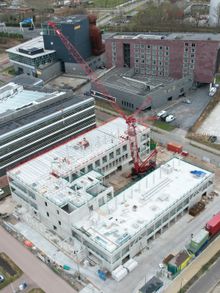 09 Oct 2025
09 Oct 2025
Located in the Leiden Bio Science Park West in the Netherlands, Nexus Leiden comprises 9,100m² over four large floors, housing state-of-the art laboratories and offices to support the critical work of life science, health and pharmaceutical companies.
With its construction site nestled in a busy science park, modular construction techniques were employed to minimize the timeline, space and on-site disruption of the building's construction.
Working closely with the project's main contractor, Dura Vermeer Bouw Zuid West, and concrete supplier Holcon BV; Mammoet supported the assembly of the building's shell structure, which was made of precast concrete and steel.
A centerpiece steel staircase structure for the atrium also needed to be installed, besides the floor slabs and appropriate connections needed for concrete pouring.
With no available space outside the build site to set up a crane or laydown area for the 2,400 assembly parts, a smart engineering approach was needed.
Mammoet's solution was just-in-time deliveries for the building blocks, and a prefabricated construction method that saw the entire structure assembled using a single crane positioned inside the building.
Early involvement FEEDs success
Engineers at Mammoet were brought into the project at an early stage, to consult during FEED, helping to guide the constructability plan and ensure that the critical path was optimized.
“It was important that we were involved from the outset,” said Frank Melse, Mammoet's Director Projects Benelux.
“We assessed that we would need to assemble the structure from the inside, and in stages. It was equally important for us to understand how we would organize incoming elements and ensure structural integrity during the build.”
With a just-in-time approach taken, strong communication with the German factory fabricating these elements was essential. Delivery schedules were agreed well in advance to streamline production and delivery schedules.
At peak times, trucks arrived at the site in two-hour intervals, six to eight times a day, bringing the materials needed.
A single 250t crawler crane, a Kobelco CKE2500, was selected to lift the components in accordance with the assembly program.
Chosen due to its compact and narrow footprint, the crane was positioned in the center of the building and construction proceeded around it, in a 'U' shape.
Assembly was divided into three phases: the back and side sections; the extension of the two side sections; and finally, the middle section, where the crane would first need to crawl backwards to create enough ground space.
The team was also involved in many of the lifting plans – detailed drawings where every element, from the steel columns to the concrete wall panels, had a designated number.
And so, during the construction phase, it was like following assembly instructions for a piece of prefabricated furniture, only on a much bigger, and more complex, scale.
Pre-fabulous construction
While much of Mammoet's work is in the safe lifting and transportation of exceptionally heavy components, projects such as Nexus Leiden demonstrate how its engineering expertise can assist with the movement and installation of complex modular projects of any scale.
When trusted to manage all aspects of the heavy lifting, Mammoet's knowledge, experience and equipment proved invaluable, when all stakeholders were working against the clock.
“There were many parts that needed to be constructed in the right order and with very little space,” closes Melse. “
We also knew that time was critical. With two years to complete the entire build, we estimated that 25% of that time would be needed for the assembly of the shell structure. Therefore, it was critical that everything ran smoothly and on time.”
-Ends-


